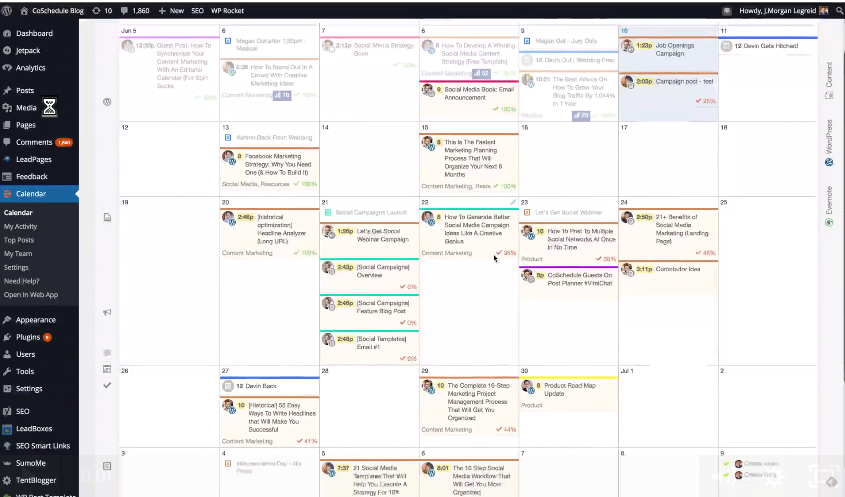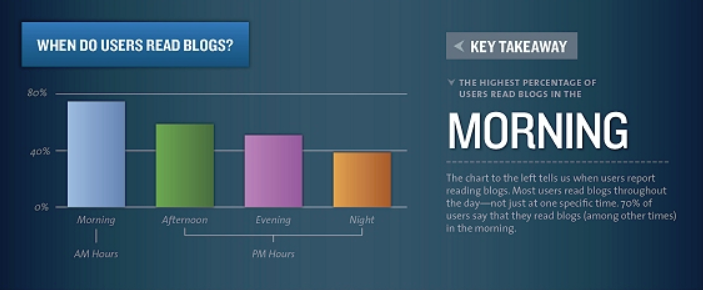
A sound blogging strategy is the bread and butter of many digital strategies.
For one, it’s a key ingredient of consistent on-site SEO.
Two, it gives you an opportunity to introduce and showcase your expertise and value to the world.
Three, it gives visitors a glance at your brand persona and gets the ball rolling on building relationships.
So you just got your WordPress site up and running and want to start blogging. What are your first steps?
Many site owners make the mistake of diving head first into blogging without a solid, long term plan. You can definitely take the “spray and pray” approach and hope something sticks, however, you probably won’t see good results for a while – if you even see results at all!
Let’s talk about how you can get your blogging strategy off the ground to help elevate your WordPress site.
Commit to a Calendar
The first step to establishing a blogging strategy is to lay out a content calendar, and more importantly, stick to it! All too often, site managers start off super jazzed about blogging and crank out a high volume of posts in a short period of time. While this is great at first, it usually tapers off pretty hard once the big ideas dry up.
For this reason, it’s very important that you commit to a realistic blogging calendar early to avoid burnout and sustain the workload. It’s much better to consistently post a few blogs per month – as opposed to a period of rapid fire followed up with radio silence.
Many companies commit to two to four posts every month. EVERY. MONTH.
CoSchedule has a fantastic WordPress plugin to map out your calendar. It allows you to easily collaborate with other content creators on the site, create task templates, and streamline the process.

In addition to laying out the workload expectancy, you should look into the best times to publish/promote your posts for the most traction. According to a study by KISSmetrics (reported on NeilPatel.com), the most ideal time to get your blog posts out there is in the morning hours.
 To dive deeper into the weeds of this study:
To dive deeper into the weeds of this study:
- Publish blog posts on Mondays at 11am EST for the most traffic.
- Publish blog posts on Monday and Thursday at 7am EST for the most inbound links.
- Publish blog posts on Saturday at 9am EST for the most comments.
Of course, these figures are not universal truths. As you publish more and more blog posts, you’re going to need to keep a close eye on your analytics to see which days/times are the best for your site individually.
Plan Out Pillar Content
So now that we’ve touched on the basics of laying the framework for your WordPress blogging strategy, we can now get into the fun stuff: creating the actual content!
The first part of this process is mapping out the topics you will cover. These should ideally be overarching categories of your business idea and subjects that you will blog about. This is called pillar content.
For example, if you are a digital marketing agency, your pillar content might be broad topics like SEO, Web Design, Content Marketing, Social Media, E-commerce, etc. Whatever you choose to be your pillar content, there needs to be a great deal of potential to expand with more specific and focused blog posts – known as cluster content.
 Ideally, the pillar content should serve the purpose of letting the search engines know what your WordPress site is all about and the value it offers to users.
Ideally, the pillar content should serve the purpose of letting the search engines know what your WordPress site is all about and the value it offers to users.
As you continue to create blog posts that fall under the realm of your pillar content (and are linked accordingly), the goal is for Google to see your website as an expert source of information on the topic. In turn, the algorithms will rank your site higher on relevant searches.
Now, keep in mind that ranking on page one of the search engine page results (SERPs) for super broad terms like “Social Media,” E-commerce,” and “Web Design” probably won’t happen in a million years – no matter how amazing your blog posts are.
The purpose of your pillar content is to act as a nucleus for how you map out subsequent blog posts. Ultimately, this helps both users and search engine robots to navigate your WordPress website more easily.
Let Keyword Trends Guide Your Ideation
Now it’s time to get into the nitty gritty aspects of planning out the individual blog posts you will write about on your WordPress website – also referred to as the topic clusters.
This is where your blogging strategy and SEO are going to be very closely related.
For starters, you need to have a trusty tool in your back pocket to perform basic keyword research. Two of my favorite keyword research tools are:
- Keywords Everywhere – Extension
- Ubersuggest – by Neil Patel
Keywords Everywhere integrates directly into your Google searches and shows you a couple key bits of information.
For one, when you make a Google search, it shows you the search volume of the query you entered – along with the CPC and competition. Second, it shows you a slew of related keywords sorted by their search volumes, CPC, and competition.

Ubersuggest is another super easy-to-use tool for keyword research. The web-based tool gives you the search volume of a term, it’s organic difficulty, paid difficulty, and how much it has been searched for month-by-month. On the side menu, Ubersuggest gives you related keyword ideas, as well as a content ideation tool.

The best part about these two resources is they are FREE!
If you want to get more in-depth with keyword research, look into paid tools like Ahrefs and SEMrush.
Now, to reiterate, your keyword research should more or less dictate the topics you write about. As you start out, you want to target the low-hanging fruit keywords with smaller search volumes. This will make it easier to gain traffic on your website.
For example, let’s say your website gives travel recommendations. You want to write a blog post about traveling to Dubai. Let’s take a look at the search volume surrounding this topic.

As you can see, “travel to Dubai” has a search volume of nearly 10,000/month. If this is going to be the focus keyword of your blog post, it’s going to be extremely tough to get ranked well on Google searches – especially if you’re first starting out.
Instead of trying to rank for “travel to Dubai,” consider reaching for the more specific keywords with smaller search volumes.

Given what we’re working with, you are better off starting your blogging strategy with posts around keywords/phrases like:
- American traveling to Dubai (90/month)
- How to explore Dubai (20/month)
- Dubai travel tips clothing (70/month)
- Dubai POI (30/month)
As you start to gain rankings for your posts on the keywords with lower search volumes, this means that Google sees you as an expert on this particular topic. In future posts, you can gradually start to create content around related keywords/phrases with higher search volumes.
In terms of on-site SEO for your WordPress website, be sure you get familiar with the Yoast plugin. This is a necessity!
Conduct Annual Content Audits
Once your blogging strategy is established, you need to make it a point to periodically return to the war room and assess your efforts with a thorough content audit.
In a nutshell, a content audit is the process in which you gather all the blog posts on your website and take an in-depth look into the metrics they are bringing in.
To round up all your content assets, use a tool like Screaming Frog. By entering in the URL of your blog section, you can quickly compile all of your posts and sort as needed. 
You’re also going to need to pull up your Google Analytics and Search Console information as you categorize and organize your blog posts.
In a spreadsheet, you need to set the columns for the criteria that is most important to your research/goals. For example, some of your columns might be the following information on each blog post:
- Date Published
- Topical Category
- Content Length
- Condition of Content – (Evergreen/Time-sensitive)
- Last Updated
- Focus Keyword
- Author
- Page Visits
- Number of Shares
- Bounce Rate
- AVG Time Spent on Page
- Desired Action
- Conversion Rate
These are just a few bits of information to get you started.
Your findings in the content audit should work to answer four key questions for each piece.
- Should this be left as is?
- Should this be updated or expanded upon?
- Should this be consolidated into another piece of content?
- Should this be deleted?
Ultimately, a content audit is you taking the time to understand the results your blogging strategy is bringing in and plan/adjust as needed for the future. This process should be done at least once every year – maybe more depending on how integral blogging is to your bottom line.
So how exactly do you answer the four major questions and take the appropriate action?
You need to have a good idea of what exactly defines a “good” blog post, a “great” one, a “mediocre” one, and a “bad” one.
This criterion is going to be unique to the goals you have with your website/blog. Start by taking an in-depth look at which metrics are most important to you.
- Is your primary goal with blog posts to gain web traffic?
- Rank for more keywords?
- Gain conversions?
- All of the above??
With this in mind, develop a grading system to sort each of your posts.
For example, if a blog post is getting 1000+ visits per month, averages more than four minutes on-page, is ranking for 10 or more keywords, has 50+ shares, and has a conversion rate of 8% or more, it might earn an A.
On the other hand, if a post is getting less than 50 visits per month, averages less than 20 seconds on-page, is ranking for no more than three keywords, has a conversion rate of less than 0.03%, and has less than 10 shares, it might earn an F grade.
The parameters you set for which metrics determine a certain grade is going to require a thorough assessment, especially if you’ve got tons of posts on your WordPress site.
So what action does a certain grade warrant?
The grades you give your blog posts can warrant a number of actions, regardless of the grade. Let’s go over some common scenarios that justify certain actions to the main questions of a content audit.
Action #1: Should this be left as is?
This will likely apply to the evergreen blog posts that earned an A or B grade. If the examples, tips, and data used still hold up with today’s standards, the post itself can probably be left alone. Why fix something that isn’t broken?
If the blog post is super popular, you can repurpose it into an infographic, video, slideshow, etc. But this is a topic for another day!
Action #2: Should this be updated/expanded upon?
This action can apply to just about any post. Although if you have a post that’s deep in the F range, it might not be worth your time. Generally speaking, this action will be more pertinent to you’re A and B range blog posts.
For instance, if a post is ranking well for a certain keyword, you can choose to update it with new, similar keywords to improve your rankings even further. Or, you can choose to expand upon it by adding on to the post or creating a new, related one.
Another situation to update a post is if the topic is related to a fast-evolving industry – such as SEO, web design, etc. As tips and data go obsolete in this niche relatively fast, you can update your posts with new stats, examples, and points of advice.
Action #3: Should this be consolidated into another piece of content?
This action will likely apply to posts that are in your B- to D+ range.
For example, let’s say you wrote a blog post on optimizing a checkout page for an e-commerce website that isn’t doing so well. But, you also wrote a post about creating product pages for an e-commerce website that’s in the B+ and above range. You could potentially consolidate the checkout post into the product page post to potentially improve the grade of the latter.
When you consolidate, be sure to set up a 301 Redirect!
Action #4: Should this be deleted?
Unless you have tons and tons of content on your website, this probably won’t be a common action.
For example, let’s say you wrote a blog post on praising a certain celebrity and their leadership style. If they got caught up in a nasty scandal and all their credibility and public perception went down the drain, deleting this post to protect your own image would be a smart move.
While the reasons can certainly vary, trashing a post you worked hard on should be a last resort.
This is just a basic rundown of how to conduct a content audit for your WordPress site. For help with this process, definitely check out the Content Audit WordPress plugin! This will make organizing your content and conducting the review process much, much easier.

Over to You
A blogging strategy is crucial in helping your WordPress site gain traction.
However, you shouldn’t think of a blogging strategy as solely beneficial to you. We are at a point in time when there is more public information available than ever before. Unfortunately, it also means that there is a lot of subpar, unreliable information out there – and Google is getting better and better at identifying the difference.
The primary goal of blogging needs to be providing expert information that actually improves people’s lives. If you can do this with your WordPress site, you will be rewarded!
Image Source: (1, 2, 3, 4, 5, 6, 7, 8)